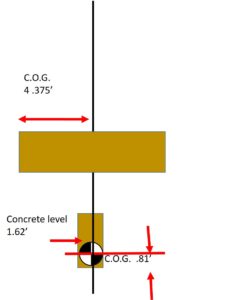In August, TactiLearning introduced the concept of using Rigging Models to Crane Network’s readers. These models enhance rigging training by presenting a properly rigged load (models) to illustrate how an instructor can explain the proper techniques of making connection to the hardware, slings, and the load.
This “Challenge to Instructors” is one of many possible uses of the TactiLearning models. Other creative-thinking scenarios may include:
- Determining load weight and center of gravity
- Sling angles and tension
- Rigging with snatch blocks
- Load rolling
The scenario presented here will use the Rigging Model as a tool to “visualize” the various weight, center of gravity, and sling tension calculations.
THE RIGGING OBJECTIVE
The Load
A simple rectangular box filled with concrete to the centerline of the box. Assume that the box itself, slings, and hardware have no weight. The box is (scale 1 inch = 1 foot):
- 3.25 ft. high
- 1.75 ft. thick
- 8.75 ft. long
The Rigging Equipment
The load is rigged as shown in the picture with the following rigging equipment:

The load is rigged with (a) 2 green slings, (b) 2 eye bolts, (c) 2 small shackles. (d) 1 medium shackle, (e) 1 master link
- a. 2 green slings
- b. 2 eye bolts
- c. 2 small shackles
- d. 1 medium shackle
- e. 1 master link
The Requirements
The load and rigging models will be used a way to visualize the scenario. The reader (acting as qualified rigger) answers a series of questions about the scenario presented by the instructor.
THE CHALLENGE: The instructor requires that the qualified rigger provide the following analysis of the rigging scenario:
- Estimate the load weight using dimensions given above.
Volume of load =
Using concrete weight of 150 lbs. / cubic ft., determine load weight = - Estimate where the center of gravity (C.O.G.) is located.
From the Bottom Up =
From Left to Right = - Estimate the sling angle to be greater than 60 degrees. Use 60 degrees for calculation.
Vertical share of load on each sling =
Actual sling tension = - Recommended required capacity for all shackles and slings.
SUGGESTED REQUIRED ANALYSIS:
- Estimate weight using dimensions:
Volume of concrete = 8.75 ft. x 3.25 ft. / 2 x 1.75 ft. = 24.8 cubic ft.
Weight per cubic ft. of concrete = 150 lbs./cubic ft.
Concrete weight = 24.8 X 150 = 3720 lbs. - The location of the C.O.G.: Since the load is filled half way uniformly, the C.O.G. is located centered along the length = 8.75 ft. / 2 =4.375 ft. from either end. Since box is 3.25 ft. high and half full of concrete, the C.O.G. is centered on concrete or 25% (.81 ft.) up from the bottom. (3.25/2/2=.81)
- The vertical share of the load on each sling will 50% of weight because C.O.G.is centered on pick points or = 3,720 / 2 = 1,860 lbs. The sling tension will be 1.15 (the 60 degree sling multiplier) times vertical share of 1,860 lbs. = 1.15 x 1,860 = 2,139 lbs.
- The slings each carry a tension 2,139 lbs., so select slings with a capacity greater than that. The lower shackles will see a load equal to sling tension = 2,139 lbs., so select shackles with a capacity greater than that, such as 1.5 tons The top shackle will see the total load of 3,720 lbs., so select a shackle with a capacity greater than that, such as 2 tons.



